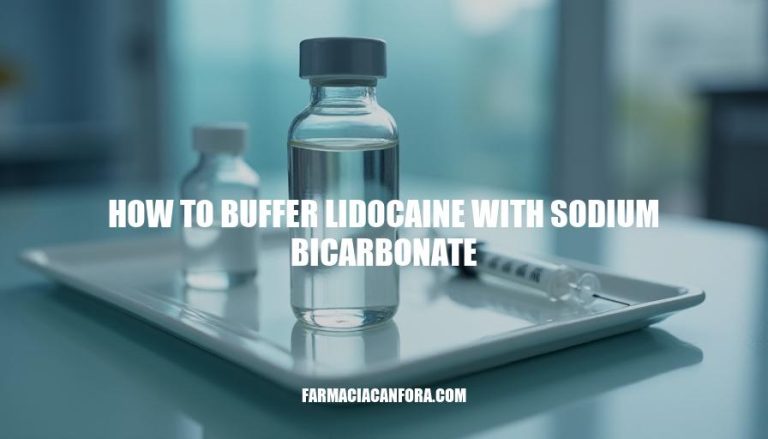


Buffering lidocaine with sodium bicarbonate is a technique used to enhance the efficacy and reduce the pain associated with lidocaine injections. Sodium bicarbonate, when mixed with lidocaine, increases the pH of the solution, making it less acidic. This adjustment can significantly reduce the burning sensation often experienced during the injection process.
Additionally, buffered lidocaine can provide a more rapid onset of anesthesia, which is particularly beneficial in office-based procedures. The combination of lidocaine and sodium bicarbonate is commonly used in various medical and dental procedures to improve patient comfort and satisfaction.
Lidocaine 1% with 1:100,000 epinephrine: 10 mL
Sodium bicarbonate 8.4%: 1 mL
Gather materials: 1% lidocaine with epinephrine, 8.4% sodium bicarbonate, two syringes, and a sterile needle.
Draw 1 mL of 8.4% sodium bicarbonate into one syringe.
Draw 10 mL of 1% lidocaine with epinephrine into the second syringe.
Attach the needle to the syringe containing sodium bicarbonate.
Inject the sodium bicarbonate into the syringe containing lidocaine.
Remove the needle and replace it with a new sterile needle.
Gently mix the solution by flipping the syringe over several times (no need to shake vigorously).
Label the syringe according to local practices.
Use the buffered lidocaine solution as needed for the procedure.
Ensure all steps are performed using aseptic techniques to maintain sterility and safety.
Preparation of Buffered Lidocaine:
Gather Materials: Obtain 1% lidocaine with epinephrine and 8.4% sodium bicarbonate.
Mixing Ratio: Use a 3:1 ratio of lidocaine to sodium bicarbonate. For example, mix 3 mL of lidocaine with 1 mL of sodium bicarbonate.
Preparation: Combine the lidocaine and sodium bicarbonate in a sterile container. Mix thoroughly until the solution is clear.
Storage: Store the buffered lidocaine in a refrigerator at 5°C (range 3°C to 8°C) to maintain stability.
Use within 7 days if containing epinephrine.
Application in Clinical Setting:
Patient Preparation: Clean the injection site with an antiseptic solution.
Assemble Syringe: Draw the appropriate amount of buffered lidocaine into a sterile syringe.
Injection Technique: Use a 25-gauge needle for subcutaneous or intradermal infiltration. Insert the needle at a 45° angle to the skin.
Administer Injection: Inject the buffered lidocaine slowly to minimize discomfort.
Post-Injection Care: Monitor the patient for any adverse reactions and ensure the area is numb before proceeding with the procedure.
Potential Use Cases:
Dermatologic Procedures: Used for minor skin surgeries, such as mole removal or biopsy.
Dental Procedures: Applied for local anesthesia during dental work, such as fillings or extractions.
Minor Surgical Procedures: Utilized in minor surgical procedures, such as laceration repair or incision and drainage of abscesses.
Pain Management: Employed for pain relief in procedures like joint aspirations or injections.
Use the correct ratio: Ensure the correct ratio of lidocaine to sodium bicarbonate (commonly 3:1) to avoid precipitation.
Mix gently: Mix the solution gently to prevent the formation of bubbles.
Warming the solution: Warm the solution to body temperature before injection to reduce pain.
Slow injection: Inject the solution slowly to minimize discomfort and reduce the risk of complications.
Monitor for adverse reactions: Be vigilant for signs of central nervous system and cardiovascular toxicity, especially if epinephrine is included.
Avoid contamination: Use sterile techniques to prevent infection.
Proper storage: Store the buffered solution properly to maintain its stability and effectiveness.
Patient monitoring: Monitor the patient closely during and after the procedure for any adverse reactions.
Buffering lidocaine with sodium bicarbonate involves mixing 1% lidocaine with epinephrine and 8.4% sodium bicarbonate in a specific ratio, typically 3:1.
The solution is then gently mixed and stored in a refrigerator at 5°C to maintain stability.
In the clinical setting, the buffered lidocaine is used for various procedures such as:
It is essential to use sterile techniques, monitor patients closely, and follow proper storage guidelines to ensure the solution’s effectiveness and safety.
The buffering process reduces the burning sensation associated with lidocaine injections, provides a more rapid onset of anesthesia, and improves patient comfort and satisfaction.